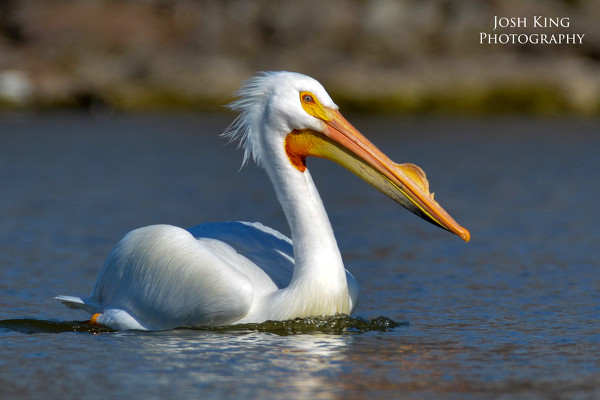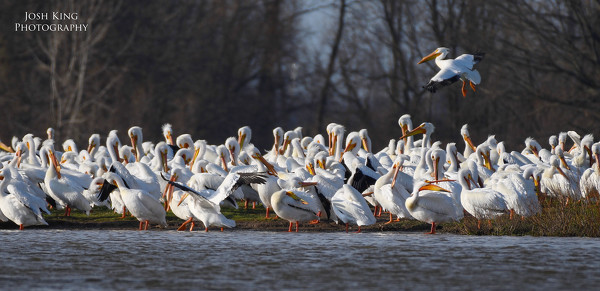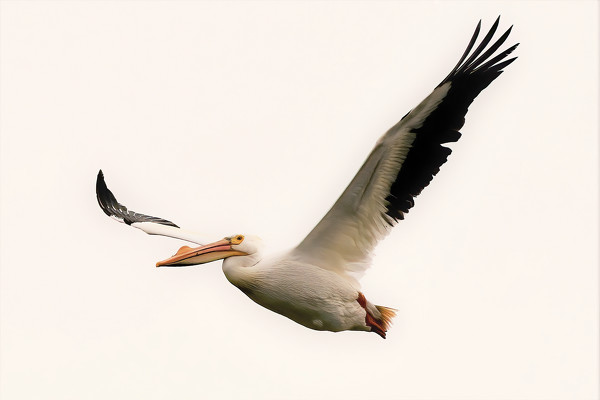Saturday, April 25th, 2020
Coming home
Pelicans flock to Grand Lake by the hundreds
By Nancy Allen

Submitted Photo
American white pelican swims on Grand Lake.
A state wildlife record may have been set when a Celina man spotted a flock of more than 600 American white pelicans on Grand Lake.
The birds, one of the largest in North America with a 9-foot wingspan, started coming to Grand Lake in larger numbers during spring and fall migrations about seven years ago.
But those sparse flocks didn't compare with the squadron Josh King, 19, of Celina spotted on April 11 at the Mercer Wildlife Area along State Route 703. Yes, a group of pelicans is called a squadron.
"I was very surprised," said King, who is an avid birder and wildlife photographer. "Last year around this same time I had counted roughly 230 pelicans there, which was about the record for the state. Someone in Ottawa County last year counted close to 360 birds, a new record. So this count on April 11 almost doubles the state record."
The first sighting of any American white pelicans the newspaper reported in recent years was in 2009, when a pair was spotted in January. Every year since, the birds have been spotted on and around the lake, and their numbers keep increasing. The last few years, groups of up to 40 or more have been common.
An Ohio bird expert said he believes the pelicans' ancestors may have frequented the area before the lake existed. The 13,500-acre canal lake was handmade between 1837 and 1845 to supply water to the Miami-Erie Canal.
"I would bet you $1,000 they nested on Grand Lake prior to the lake being built because it was a big, wet prairie. That would have been white pelican breeding habitat," said Jim McCormac, a birder, botanist, writer and wildlife photographer from Columbus. "The deeper reason is its history. These migratory patterns get imprinted in their genetics. Migratory birds will keep flying over these ancestral areas even if they have been destroyed. It totally fits with the historical records that they would have nested there prior to the 1830s. They have this predisposition to wander this way."
McCormac said American white pelicans are freshwater, inland birds mostly and nest and breed predominantly in the northern Great Plains of the U.S. Brown pelicans are the type most often seen on the ocean, he said.
McCormac noted that where prairies have been restored in places they naturally had occurred, the response from migratory birds has been instantaneous.
"They come right back," he said.
American white pelicans used to be more common but declined for a few decades due to habitat loss and persecution by people who believed they were eating game fish, McCormac said. Anglers need not worry, as they eat mostly rough fish such as carp, shad and suckers.
"When they were common, (Grand Lake) was a common place for them. It goes back to the late 1800s for pelicans on Grand Lake. This is one of the first places in Ohio documented to have them."
The publication "The Birds of Lake St. Marys," first published in the 1940s and updated in 2001, noted the lake was a good place for American white pelicans dating back to the 19th and 20th centuries, McCormac said. Until the early 2000s, no more than a few were seen in Ohio in one place, but their numbers have skyrocketed since then, he added.
The birds have been spotted at other nearby canal lakes such as Indian Lake in Logan County and Lake Loramie in Auglaize and Shelby counties. Lake Erie also has seen larger flocks in recent years, he said.
The birds have not been documented nesting in Ohio, yet, but that may change.
"They actually bred on a little island between Canada and Lake Erie a few years ago," McCormac said. "So they haven't nested in Ohio yet, but they have come pretty close."
King noted that their nesting range has moved farther east, putting Grand Lake in better range for stopovers during migration.
"Their range has been pushing eastward to the Great Lakes," he said. "They only used to nest in central Canada and Wisconsin, Minnesota and Montana. But in recent years there have been large populations nesting in the Great Lakes area."
Asked if it's possible the birds might nest on Grand Lake, McCormac said yes.
"American white pelicans don't like to be disturbed and typically nest on islands," he said. "If someone built an island in the middle of Grand Lake they would probably breed and nest."
Upon being informed the lake already has an island in the middle called Safety Island, McCormac replied, "you will have to keep an eye on that."
If the myriad photos and posts on social media about the pelicans are any indication, local birders and wildlife enthusiasts are glad they are here. The Friends of Grand Lake Facebook page is full of their photos.
Birds returning to areas that haven't frequented in decades can become huge ecotourism magnets, McCormac said.
"When you start to get these 16-pound birds with nine-foot wingspans, even a lot of people who aren't really interested in birds will come to see that," he said. "That can directly translate into money if something like this becomes stable."
Former visitors:
An Ohio bird expert says he believes American white pelicans nested here before the lake was built between 1837-1845. The area that is now Grand Lake was a big, wet prairie, perfect for
the aquatic birds.
American white pelican facts:
One of the largest birds in North America by weight. Only the California condor has a broader wingspan.
9-foot wingspan, powerful fliers.
Bill sac holds 3 gallons of water.
Weigh between 10 and 20 lb. The record is 30 lbs.
Scoop up fish in their bill sacs while swimming.
Both sexes grow a flat horn on their upper bill in the spring during mating season. It later falls off.
Fish communally by forming a line to herd fish into shallows near shore before consuming.
The only place near the lake that draws these migratory pelicans in great numbers is Goose Pond 95 miles southwest of Indianapolis.

Submitted Photo
This group of Amerian white pelicans photographed by Celina resident Josh King is among a flock of more than 600 that landed at the Mercer Waterfowl Area on April 11, a possible new state record for the largest number of the aquatic birds in Ohio at one time.

Submitted Photo
An American white pelican soars near Grand Lake in this recent photo. The aquatic birds with 9-foot wingspans are powerful fliers and love to soar.

